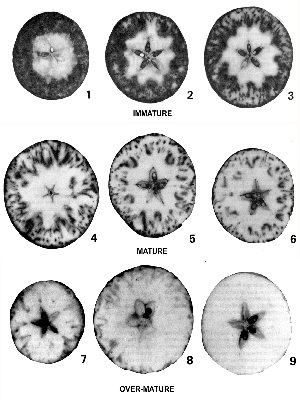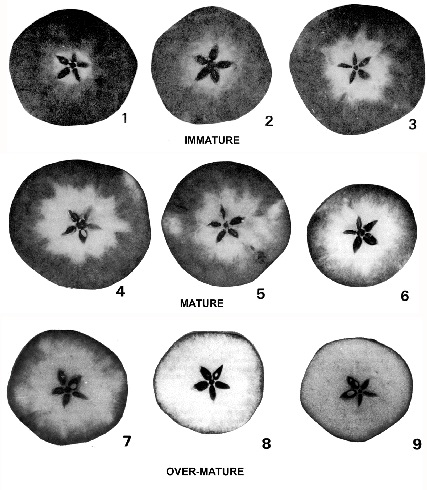Evaluating maturity of McIntosh and Red Delicious apples
Learn how to do the starch-iodine test which is one of several methods that can be used to determine fruit maturity for McIntosh and Red Delicious apples.
ISSN 1198-712X, Published March 2000.
Introduction
As apple fruits mature and ripen, the starch in the immature fruit changes to sugar. This decreasing level of starch as it converts to sugar can be measured by dipping a portion of the apple into an iodine solution. The starch reacts with the iodine solution to produce a blue-black colour in a pattern characteristic for that cultivar. Where there is no reaction and no colour change, sugar has developed. This colour intensity and pattern can be compared to a pictorial chart to estimate the internal fruit maturity.
Pictorial charts have been developed for several apple cultivars. This starch-iodine method for estimating internal fruit maturity was first developed for McIntosh, so the most field experience has been obtained with this cultivar. This testing method is also reliable for Red Delicious.
A similar pictorial reference has been developed for Spartan, Empire and Idared apples. For more details, refer to OMAFRA fact sheet, Evaluating maturity of Empire, Idared and Spartan apples.
When used with other estimations of when to harvest apples, this Starch-Iodine Test can provide a reasonable measure of fruit maturity.
Iodine solution
Always make up a fresh solution at the beginning of the harvest season. Keep this solution in a dark coloured (or foil-wrapped) bottle and away from light. A pharmacist or anyone with a sensitive weighting device can use these directions to make up the iodine solution.
Warning
Iodine is a poisonous chemical. This iodine solution should be correctly labeled and kept away from children and pets. Consider treated apples poisonous and do not feed to any animal or use in composting. Do not allow pets to lick the fruit after testing.
Ingestion of iodine or iodine-treated apples should be followed quickly by induced vomiting and consultation with a physician.
Recipe
- Dissolve 8.8 grams of potassium iodide in approximately 30 ml of warm water. Gently stir the solution until the potassium iodide is properly dissolved.
- When it is properly dissolved, add 2.2 grams of iodine crystals. Shake the mixture until the crystals are thoroughly dissolved.
- Dilute this mixture with water to make 1.0 litres of test solution. Mix them well.
Taking the apple samples
Begin sampling and testing 2 weeks before the anticipated harvest date. Randomly collect apples from different areas on several trees of the same cultivar. A minimum sample of 10 apples is used for each test, with 15–20 fruit providing a more reliable estimation.
Testing the fruit sample
Do not attempt to test apples if the iodine solution has not been recently prepared. The apples must be recently harvested. If the temperature of the apples, or of the iodine solution, is less than 10°C (50°F), inaccurate readings are likely to result.
Pour the iodine solution into a shallow glass container to a depth of 5–8 mm. Cut each apple in half across the core and immerse the exposed surface (of one of the halves) in the iodine solution. The apple stem can serve as a convenient handle, if the top half is used.
Wait 1 minute before removing the apple half. Rinse with water if available. A squirt bottle, or a slowly running stream from a tap will work well. Although the original research used to develop this test recommended rinsing after treatment, field experience in Ontario indicated that most results are satisfactory even if rinsing is not done.
Repeat with the next apple until at least 10 apples have been treated.
Dispose of the used iodine solution in a safe manner.
In 2 to 3 days, repeat this test with another sample of freshly picked apples until you determine the correct harvest maturity for the intended market.
Starch iodine tests — pictures
Evaluating the results
Rate each fruit by a visual comparison with pictorial chart and record the number of the corresponding pattern. An average rating of all the apples should be calculated to determine the fruit maturity rating.
For McIntosh apples harvested for regular Controlled Atmosphere (CA) storage, apples are sufficiently mature when they reach a rating of 4. However, with use of more efficient cooling equipment, careful handling and rapid transit to the storage, McIntosh apples harvested at a rating of 2.5 to 3.0 are more acceptable for long-term CA storage, or low oxygen storage.
Apples continue to be suitable for regular CA storage as long as they have a rating of 4, 5 or 6. However, the more mature apples should be held for a shorter storage period. Fruit with a rating greater than 6 will have more flavour and a softer texture and be better suited for immediate consumer use. Such fruit may be successfully stored for a short period of time, but should be marketed while their superior eating qualities are still present.
For Red Delicious, the first acceptable harvest for CA storage occurs when the fruit rating reaches 2.5 to 3. Expect a significant variation in the starch/sugar content between different Red Delicious strains. Note that the starch changes in this cultivar are less well defined than in McIntosh.

